- home
- BAKERECIPES
BakeRecipes
Bringing real baking into your home with deliciously simple recipes.
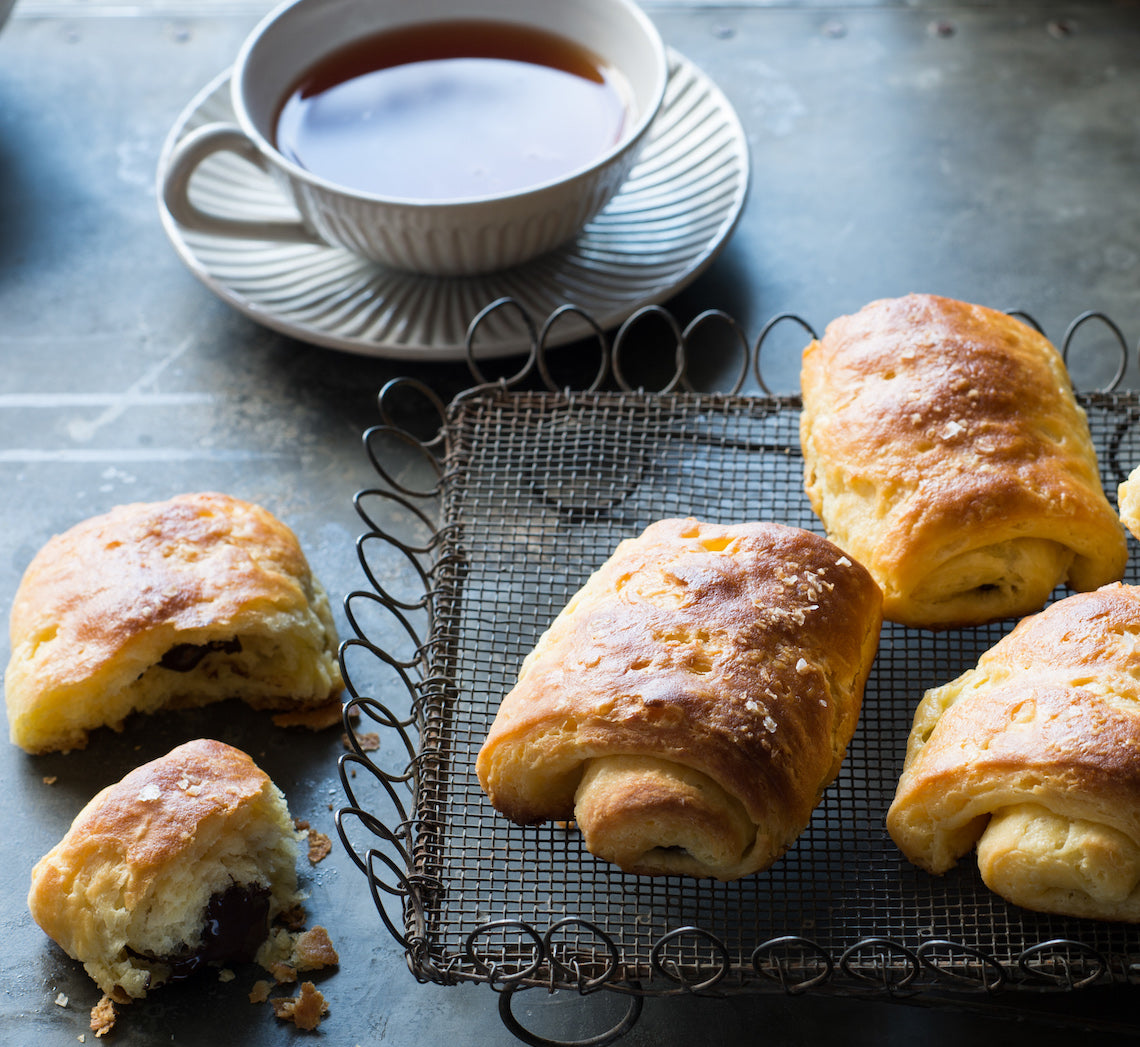
Prep 40min (+ overnight proving and 30min chilling time)Bake 25minMakes 8
At their best warm from the oven, these classic French pastries are based on the same pastry as a croissant, known as a leavened puff pastry (basically a puff pastry with yeast). These pain au chocolat uses a cheat’s pastry of sorts and gives a similar, less refined, result as the traditionally-made pastry, without the hassle of having to interleave the butter with the pastry dough as you fold it. The light sprinkling of sea salt flakes adds a surprising yet pleasant contrast to the sweetness of the chocolate centre.
Ingredients
125ml (½ cup/4fl oz) lukewarm milk
2 teaspoons (7g/¼oz 1 sachet) instant dried yeast
250g (1⅔ cups/9oz) bread flour (see Baker's Tips), plus extra to dust
185g (6½oz) chilled butter, cut into 2cm cubes
1 egg, at room temperature, lightly whisked,
2 tablespoons caster sugar
125g 4½oz) good-quality dark chocolate, chopped
1 extra egg, lightly whisked with 2 teaspoons milk, to glaze
Sea salt flakes (optional), to sprinkle
Icing sugar (optional), to dust
Method
- Put the milk in a medium bowl, sprinkle the yeast over the top and stir with a fork. Set aside for 5 minutes.
- Put the flour and butter into the bowl of a food processor and use the pulse button to process until the butter is cut into rough 1cm/½in pieces (make sure you don’t process any further). Transfer to a large bowl.
- Add the egg and sugar to the milk mixture and stir to combine. Add to the flour and butter mixture and use a wooden spoon and then your hands to mix until it is just combined and a soft dough forms. Cover the bowl with plastic wrap and place in the fridge overnight.
- Turn the dough onto a lightly floured surface and bring together with your hands. Knead briefly or until just smooth but the butter pieces are still visible. Shape into a rectangle and then use a lightly floured rolling pin to roll out until about 25cmx40cm/10inx16in, keeping the edges as straight as possible. With a long side nearest to you, fold the right third of the dough in to cover the centre third and then fold the left side in also. Turn the dough clockwise a quarter turn. Fold the dough into thirds as before to make a small rectangle.
- Flip the dough over on the bench so that the open edge is now underneath and repeat the rolling and folding process again as in step 4. You will finish with a small rectangle. Wrap well in plastic wrap and chill for 30 minutes.
- Preheat the oven to 190°C/375°F (170°C/340°F fan forced). Line a large baking tray with non-stick baking paper.
- Roll out the pastry with a lightly floured rolling pin on a lightly floured surface to a 30cm/12in square, about 5mm/¼in thick. Cut in half to make two 15cmx30cm/6inx12in rectangles, and then cut each into quarters so you end up with eight 7.5cmx15cm/3inx6in rectangles. Divide the chocolate evenly between the rectangles, placing it across the shorter end of each. Starting from the short end with the chocolate, roll the dough around the chocolate to form a roll. Place on the lined tray, seam-side down, and flatten slightly with the palm of your hand. Cover loosely with a slightly damp tea towel and set aside in a warm, draught-free place for 15 minutes or until the pastry has risen slightly and is ‘puffy’.
- Brush the pastries lightly with the egg and milk glaze and sprinkle with a little sea salt flakes, if desired. Bake in preheated oven for 25 minutes or until the pastry is golden, crisp and cooked through. Serve warm or at room temperature sprinkled with icing sugar, if desired.
CLICK HERE for more Bakeproof recipes.
Photography by Alan Benson.
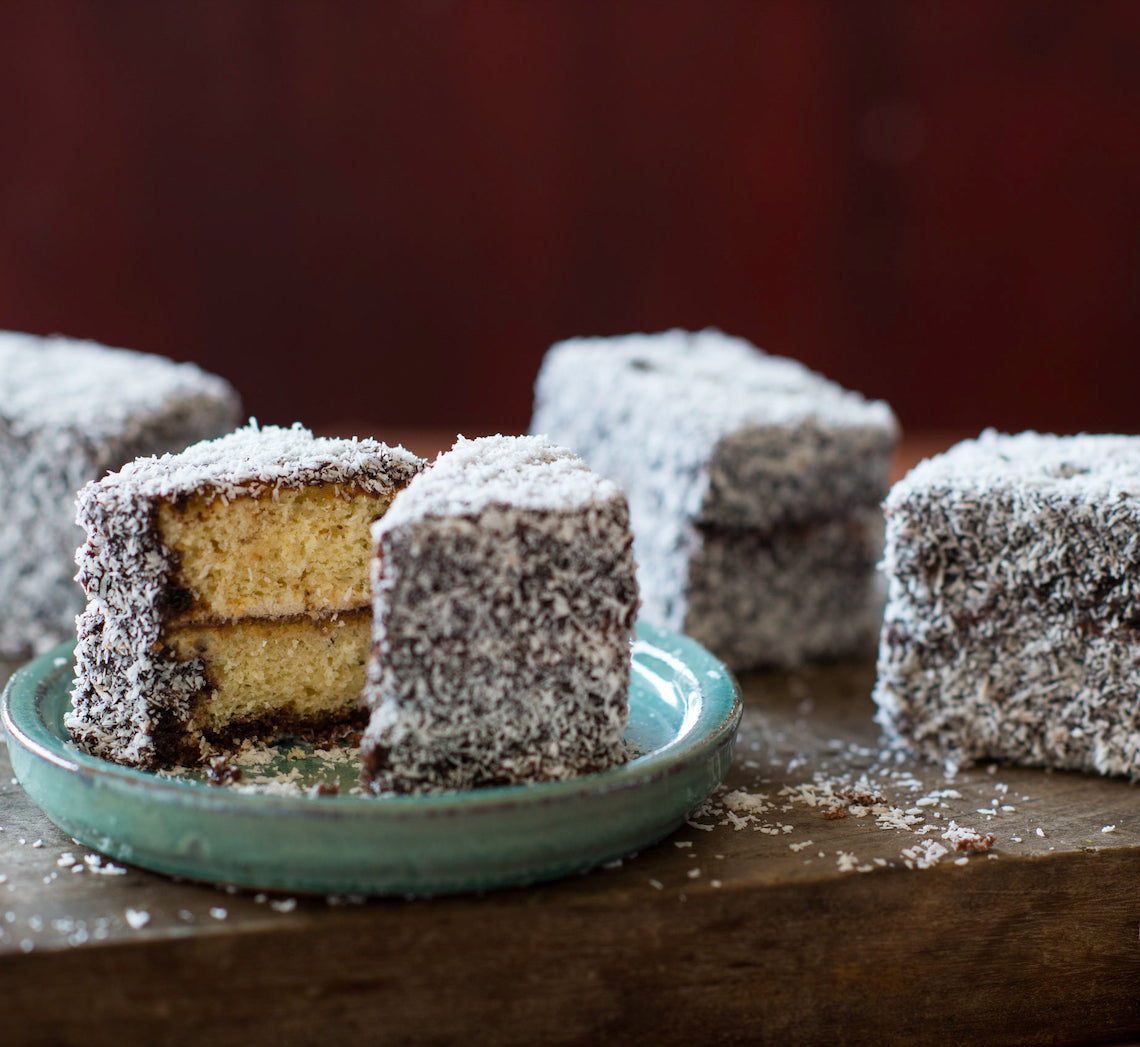
Prep 40min (+ 40min cooling and 20min chilling time)
Bake 20minMakes 9
Gluten-free cakes are sometimes hard to come by. Moist and flavoursome, these lamingtons won’t disappoint. Those with gluten or wheat intolerances and sensitivities won’t ever have to compromise if wanting to enjoy this Australian classic.
Ingredients
80ml (⅓ cup) thickened cream, whisked to firm peaks180g (2 cups) desiccated coconut, to coat
Gluten-free buttercake
175g (1¼ cups) purchased gluten-free plain flour mix2½ teaspoons gluten-free baking powder
165g (¾ cup) caster sugar
125g unsalted butter, cubed, softened
2 eggs, at room temperature
80ml (⅓ cup) milk
2 teaspoons natural vanilla extract or essence
Chocolate icing
465g (3¾ cups) pure icing sugar55g (½ cup) cocoa powder
150ml boiling water
1½ teaspoons vanilla essence
Method
- To make the gluten-free buttercake, preheat the oven to 180°C. Grease a 20 x 30cm (base measurement) shallow cake tin and line the base and two longs sides with one piece of baking paper.
- Put the flour, baking powder, sugar, butter, eggs, milk and vanilla in a large mixing bowl. Use an electric mixer to beat on low speed until combined. Increase the speed to medium and beat for 3 minutes or until the mixture is well combined and very pale in colour. Spoon the mixture into the lined tin and spread evenly using the back of a spoon. Lightly tap the tin on the bench 3 times to get rid of any excess air bubbles.
- Bake for 20 minutes or until cooked when tested with a skewer. Cool for 5 minutes in the tin, then turn onto a wire rack to cool completely (this will take about 40 minutes).
- To make the Chocolate Icing, sift the icing sugar and cocoa powder into a medium bowl. Add the boiling water and vanilla and stir until smooth (it should be the consistency of pouring cream).
- Trim the edges of the cooled cake and then cut in half to form two layers about 20 x 15cm. Spread one half of the cake with a little of the Chocolate Icing and then spread whipped cream. Top with the remaining cake half. Chill for 20 minutes or until the cream is firm enough to cut the cake.
- Use a sharp serrated knife to cut the layered cake into 9 portions (about 6.5 x 4.5cm each). Run a palette knife around the cut surface of each lamington to remove any excess cream.
- Spread the coconut on a tray or plate. Rest a cake portion on a fork, dip into the chocolate icing and then and spoon the icing over the top and sides to completely coat. Allow any extra icing to drip off. Roll the cake in the coconut to coat evenly. Place on a wire rack. Repeat with the remaining cake portions, icing and coconut.
Baker's Tips
- If the icing becomes too thick while you are coating the cake pieces, stir in enough extra boiling water, adding it a teaspoon at a time, to thin to the right consistency.
- These lamingtons will keep in an airtight container in the fridge for up to 2 days. Stand at room temperature for at least 30 minutes before serving.
This recipe is from Anneka's SBS Food online column Bakeproof: Lamingtons. CLICK HERE for more Bakeproof recipes.
Photography by Alan Benson.
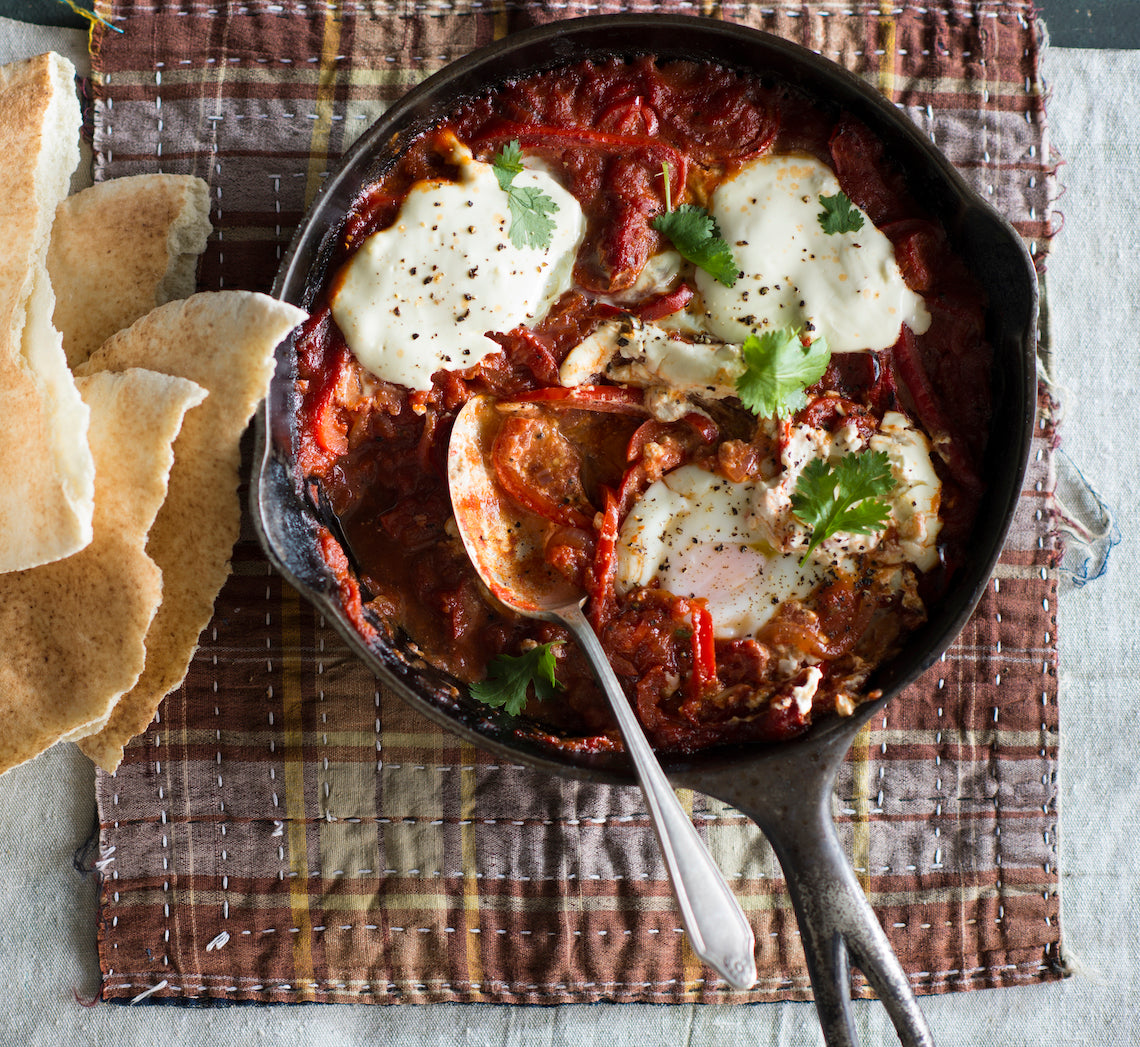
Prep 35minBake 12-18minMakes 6 serves
Nestled in an aromatic, slightly spicy tomato and capsicum sauce and topped with tangy yoghurt, these baked eggs, originally from Tunisia, make for a wonderful centre-of-the-table brunch dish. Serve with pita bread and let everyone help themselves.
Ingredients
1 tablespoon (20ml/¾fl oz) olive oil
2 red capsicum, deseeded, cut into thin strips
1 red onion, halved, sliced
1 teaspoon ground cumin
½ teaspoon dried chilli flakes
2 x 400g (14oz) cans diced tomatoes
Salt and freshly ground black pepper
6 x 60g (2oz) eggs, chilled
200g (7oz) Greek-style natural yoghurt
1 garlic clove, crushed
2 teaspoon fresh lemon juice
½ cup coriander leaves, to serve
Pita bread, to serve
Method
- Preheat oven to 220ºC/425°F (200ºC/400°F fan-forced). Heat the oil in a medium frying pan or saucepan and cook the capsicum and onion over medium heat for 15 minutes, stirring occasionally, or until tender. Add the cumin and chilli flakes and cook for a further 1 minute or until aromatic. Add the tomatoes, bring to a simmer and cook for 10 minutes or until reduced to a good sauce consistency. Season with salt and pepper.
- Spread the sauce over the base of a shallow 1.5 litre capacity (6 cup/2pt 10fl oz) ovenproof dish. Use the back of a spoon to make 6 indents in the sauce. Crack the eggs, one at a time, into a small dish and then gently slide into the indents, taking care not to break the yolks. Combine the yoghurt, garlic and lemon juice and spoon half of this mixture around the eggs, in about 6 spoonfuls. Reserve the remaining yoghurt mixture for serving.
- Bake for 12-18 minutes (see Baker's Tips) or until the eggs are just cooked but still soft in the centre. Serve immediately sprinkled with pepper and coriander, and accompanied by the reserved yoghurt mixture and pita bread.
Baker's Tips
- If using an ovenproof frying pan, you can make the sauce and then bake the eggs in the same pan.
- The baking time of the eggs will depend on the pan or dish you are using and the temperature of the sauce when you first added them.
- These baked eggs can also be baked in 6 individual 185 ml (¾ cup/6½fl oz) ovenproof dishes or ramekins. Divide the sauce between the dishes, make an indent in each and add an egg. Top with a spoonful of yoghurt and bake for 12-15 minutes or until the eggs are just cooked but still soft in the centre.
This recipe is from Anneka's SBS Food online column, Bakeproof: Autumn Brunch.
CLICK HERE for more Bakeproof recipes.
Photography by Alan Benson.

Prep 20min (+15min cooling time)Bake 25minMakes 12
I always say that muffins should have substance – they shouldn't have "cakey" character. After all, they're muffins, not cake! Dense with apple, sweet with spice and topped with pecans these muffins are one of my favourites.
Ingredients
150g plain flour
150g wholemeal plain flour
1 tablespoon baking powder
2 teaspoon ground cinnamon
150g (¾ cup, firmly packed) brown sugar
2 (about 180g each) apples (such as Golden Delicious, Pink Lady or Royal Gala), peeled and cut into 1.5 cm pieces
185ml (¾ cup) buttermilk (see Baker's Tips)
80ml (⅓ cup) light olive oil (see Baker's Tips)
2 eggs, at room temperature
1½ teaspoon natural vanilla essence or extract
75g (¾ cup) pecans, coarsely chopped
60ml (¼ cup) pure maple syrup
Method
- Preheat the oven to 190°C. Line 12 x 80ml (⅓ cup) muffin tray holes with muffin paper cases.
- Sift together both the flours, the baking powder and cinnamon into a large mixing bowl, returning any husks to the bowl. Stir in the sugar and apple and make a well in the centre.
- Use a fork to whisk together the buttermilk, oil, eggs and vanilla in a bowl. Add to the flour mixture and use a spatula or large metal spoon to fold together until just combined. (Don’t overmix – the batter should still be a little lumpy.)
- Spoon the mixture into the paper cases, dividing evenly. Sprinkle with the pecans and then drizzle with the maple syrup.
- Bake in preheated oven for 25 minutes or until the muffins are golden and cooked when tested with a skewer. Cool for a few minutes in the tin before transferring to a wire rack. Serve warm or at room temperature.
Baker's Tips
- If you don't have any buttermilk in the fridge, replace it with 160ml (⅔ cup) full-cream milk mixed with 2 teaspoons lemon juice.
- You can replace the light olive oil with sunflower or safflower oil.
- These muffins are best eaten the day they are baked, however they freeze well – wrap individually in plastic wrap and then seal in a plastic bag or airtight container. Freeze for up to 3 months. Thaw at room temperature.
This recipe is from Anneka's SBS Food online column, Bakeproof: Apples. CLICK HERE for more Bakeproof recipes.
Photography by Alan Benson.
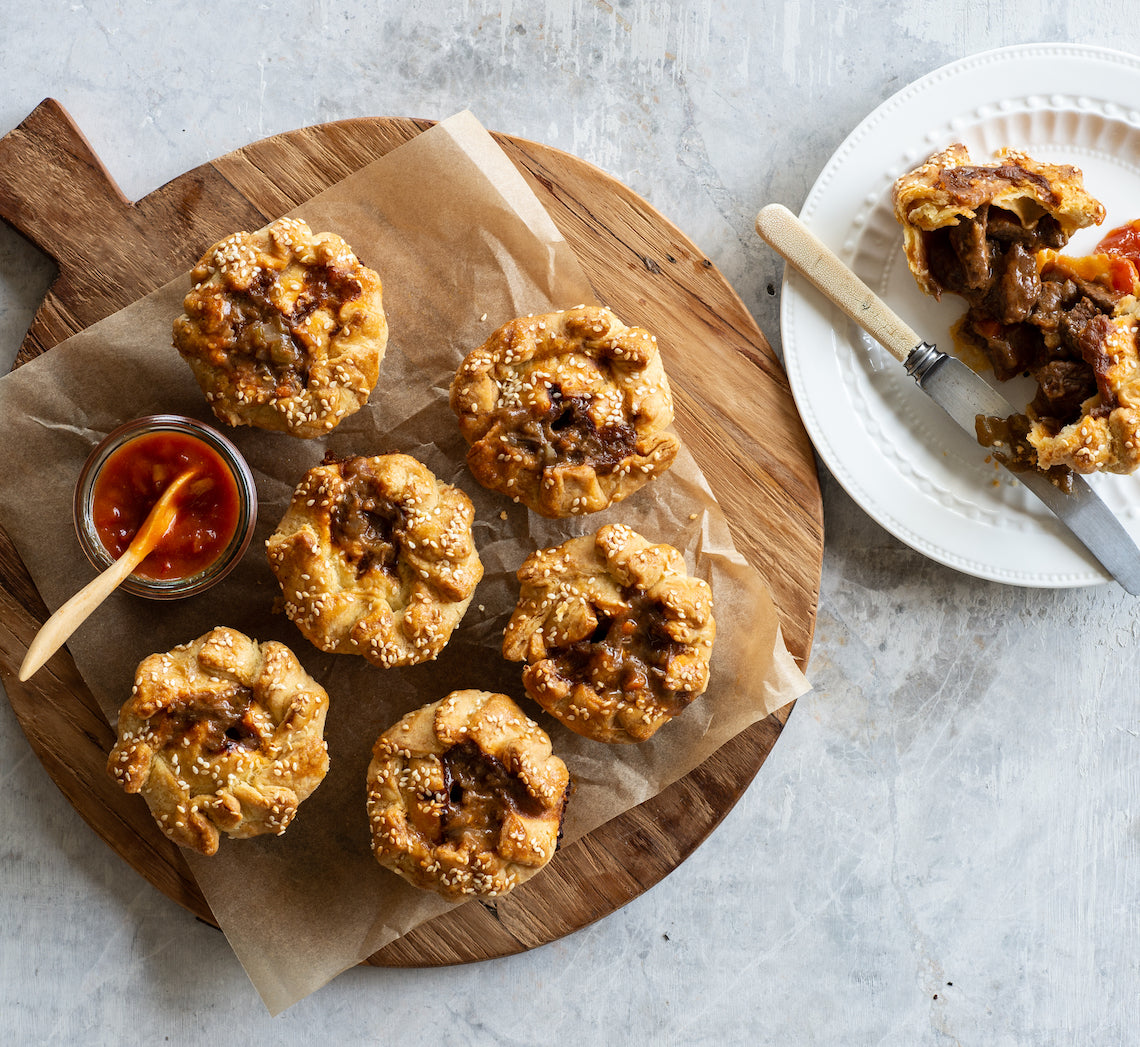
Prep 1hr (+ 2hr cooling and pastry making time)Bake 45-50minMakes 12 small pies
Meat pies are the quintessential Aussie bakery favourite... But they are even better when homemade!
Ingredients
3 quantities Basic Shortcrust Pastry, each quantity shaped into a disc before wrapping and chilling as directed
1 egg, lightly whisked
Sesame seeds, to sprinkle (optional)
Filling
35g (1¼ oz/¼ cup) plain flour
Salt and freshly ground black pepper, to taste
1kg (2lb 3oz) trimmed chuck steak, cut into 2cm (¾in) pieces (see Baker's Tips)
60ml (2fl oz/¼ cup) olive oil
1 large brown onion, chopped
1 celery stalk, trimmed and diced
1 carrot, peeled and diced
2 garlic cloves, finely grated or chopped
1 tablespoon tomato paste
250ml (9fl oz/1 cup) good-quality beef stock
500ml (17fl oz/2 cups) water
1 tablespoon Worcestershire sauce
Method
- Season the flour with salt and pepper. Place in a large bowl with the diced steak and toss to coat.
- Heat 1 tablespoon of the oil in a large heavy-based saucepan over a high heat and cook half the diced steak, stirring occasionally, for about 5 minutes or until sealed. Remove from the pan, scraping any cooked-on bits from the base, and set aside. Repeat with another tablespoon oil and the remaining steak.
- Clean the pan. Add the remaining 1 tablespoon oil, onion, celery and carrot and cook over a medium heat, stirring occasionally, for 10 minutes or until the onion starts to soften. Add the garlic and cook for a further 1 minute, stirring occasionally, or until aromatic. Add the tomato paste and cook, stirring for 1 minute. Return the steak to the pan with the stock, water and Worcestershire sauce and bring to a simmer.
- Reduce heat to low, cover with a piece of baking paper and simmer, covered, for 1 hour, stirring occasionally. Uncover and then simmer for a further 1 hour, stirring frequently or until the meat is tender and the liquid has reduced to a thick sauce consistency. Transfer the mixture to a heatproof bowl, cover loosely and place in the fridge, stirring occasionally, until cooled to room temperature (this will take about 2 hours).
- When ready to assemble the pies, preheat oven to 200°C/400°F (180°C/350°C fan-forced). Unwrap one of the pastry discs and place on a lightly floured, cool bench top. Use a lightly floured rolling pin to roll the pastry disc until about 3mm (1⁄8 in) thick. Use a 14cm (5½in) pastry cutter, saucer or upturned bowl as a guide to cut out 6 rounds, re-rolling any leftover pastry if necessary. Gently ease the pastry discs into the holes of an ungreased 12-hole 80ml (2¾fl oz/1⁄3 cup) muffin tray to line six holes. Use your fingertips to press it gently into the corners without stretching it – the pastry will reach above the top of the muffin pans and buckle slighlty. Repeat with another pastry disc to make 12 pastry cases in total. Divide the steak mixture between the pastry cases to fill (you may have a little mixture left over).
- Roll out the remaining pastry to about 3mm (1⁄8in) thick and use a 7cm (2¾in) round pastry cutter to cut out 12 lids. Use a small sharp knife to cut a small steam hole in the centre of each round (see Baker’s Tips). Place a lid over the mixture to cover each pie, brush each lid with the whisked egg and then fold the excess pastry from the bases over the top of the lids, crimping and pressing together to seal. Brush the top of each pie with some more of the remaining egg wash and sprinkle with sesame seeds, if using.
- Bake the pies in preheated oven for 45-50 minutes or until the pastry is cooked through and golden. Stand the pies in the tin for 5 minutes before turning out and serving.
Baker's Tips
- You will need about 1.5kg untrimmed chuck steak for this recipe.
- You can also make the steam holes in the pastry lids by using a 1cm piping nozzle to cut a hole in the centre of each lid before placing it on top of the pies.
- These pies will keep in an airtight container in the fridge for up to 2 days. Reheat in an oven preheated to 160°C/315°F (140°C/285°F fan-forced) for 10-15 minutes or until heated through.
- To freeze, wrap individually in plastic wrap and then seal in an airtight container or freezer bag and freeze for up to 3 months. Thaw in the fridge before reheating (see above tip).

Prep 50minBake 35-40minMakes about 40
When the French profiteroles arrived in Brazil, a bakery in Sao Paulo created its own version – the Carolinas. Instead of filling the profiteroles with vanilla custard, they used pure dulce de leche then it became one of the staples in Sao Paulo bakeries.
This version, created by Make Me a Baker student Ana Moreno for her graduation, includes cream to make them less sweet than the ones you find in Sao Paulo, but still with plenty of dulce de leche to give the authentic taste.
Ingredients
1 quantity Basic Choux Pastry
150g good-quality dark chocolate (45-54% cocoa), chopped into small pieces
Edible gold leaf flakes, to decorate
Dulce de Leche Cream
250ml (1 cup) thickened cream
30g (¼ cup) icing sugar, sifted
1 teaspoon vanilla bean paste
320g (1 cup) dulce de leche
Method
- To make the profiteroles, preheat oven to 200°C (180°C fan-forced). Line 2 large oven trays with non-stick baking paper.
- Spoon the choux pastry into a large piping bag fitted with a 0.9cm (#9) round piping tip. Pipe 3cm rounds onto the lined trays, about 2cm apart. Use a damp fingertip to smooth any peaks on each of the rounds. Sprinkle the lined tray with a little water.
- Bake in preheated oven for 20 minutes or until well puffed and golden. Reduce the oven to 180°C (160°C fan-forced) and bake for a further 15-20 minutes or until golden and crisp on the outside. Remove from the oven and use a 0.7cm (#7) star piping tip to make a hole in the base of each of the hot profiteroles for the steam to escape. Place hole side up on a wire rack and allow to cool completely
- To make the Dulce de Leche Cream, combine the cream, icing sugar and vanilla bean paste in a mixing bowl and use a balloon whisk or hand held beaters with a whisk attachment to whisk on medium-high speed until soft peaks form.
- Spoon dulce de leche into a medium bowl. Add a third of the whipped cream mixture and use a large metal spoon or spatula to fold gently through the dulce de leche to retain as much air as possible until just combined evenly. Add the remaining cream in two more batches folding gently until just combined.
- Place the Dulce de Leche Cream into a pastry bag fitted with a 0.7cm (#7) star or round piping tip. Insert the tip into the hole in the base of a profiterole and fill with the Dulce de Leche Cream.
- To decorate the profiteroles, place the chocolate in a heatproof bowl and set over a saucepan of simmering water (make sure the water doesn’t touch the base of the bowl). Stir occasionally until the chocolate melts and is smooth.
- Dip the tops of each of the filled profiteroles in the melted chocolate to coat and set aside on a wire rack to stand for 10 minutes. Carefully decorate each profiterole with a little edible gold leaf before the chocolate is fully set.
Baker's Tip
- The unfilled profiteroles will keep in an airtight container at room temperature for up to 1 day. They are best eaten the day they are filled with the Dulce de Leche Cream.
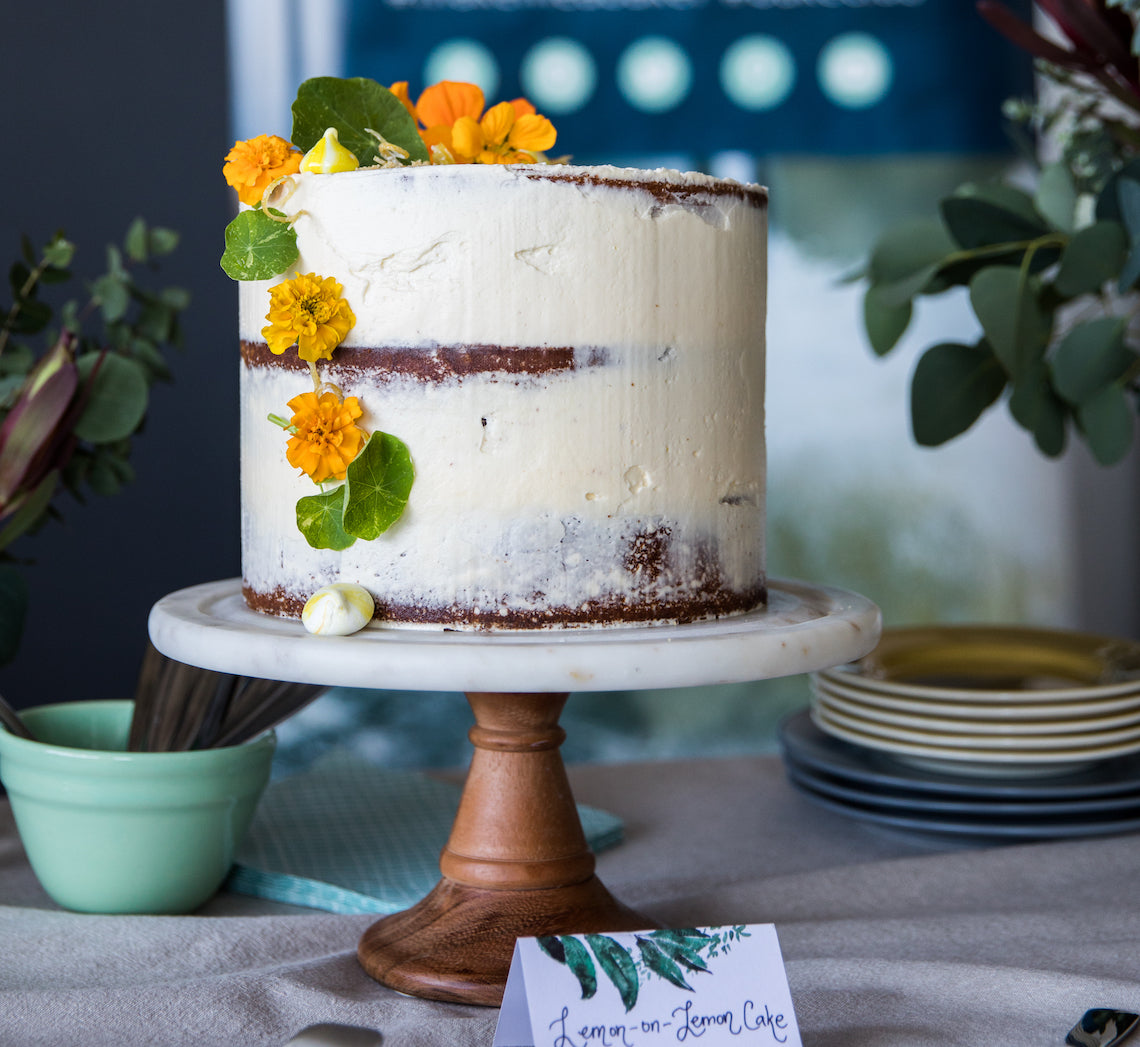
Prep 1hr45min (+ preparation time for Lemon Drizzle Pound Cakes, Swiss Meringue Buttercream and Striped Meringue Kisses)Bake 20minMakes about 20 serves
Created by Make Me a Baker student Janet Jackson for her graduation, this gorgeous cake brings together a selection of the techniques that she learnt during the 6-month program.
Janet said, "I love to bake cakes and have always admired decorated cakes but have never had the confidence to try one for myself. For my graduation bake, I wanted to bake and decorate a cake using produce from my garden at home and techniques I had learnt through the MMAB program. I trialled many different versions of lemon cake, some with poppy seeds and others with sour cream and Greek yoghurt, before settling on this delicious lemon drizzle cake which is lusciously moist and filled with the zing of freshly picked lemons."
Ingredients
Edible flowers, to decorate (optional)
3 Lemon Drizzle Pound Cakes
2 quantities Swiss Meringue Buttercream
5-15 yellow Striped Meringue Kisses
Lemon Curd
2 eggs, at room temperature
2 egg yolks, at room temperature
165g (¾ cup) caster sugar
80g unsalted butter, diced
2 tablespoons strained freshly squeezed lemon juice
Finely grated zest of 2 lemons
Lemon Crumb
60g unsalted butter, chilled, diced
80g plain flour
50g caster sugar
1 tablespoon strained fresh lemon juice
1 teaspoon finely grated lemon zest
Candied Lemon Curls
220g (1 cup) caster sugar
250ml (1 cup) water
½ lemon
Method
- To make the Lemon Curd, use a balloon whisk to whisk the whole egg, egg yolk and sugar in a medium saucepan until smooth. Add the butter, juice and zest and stir continuously with a wooden spoon until the mixture thickens enough to coat the back of a spoon (if you run your finger across the back of the spoon through the curd a line should remain when ready and the mixture should be 70°C on a sugar thermometer). Do not boil. Stain through a sieve into a bowl (see Baker’s Tips). Cover the surface of the curd with plastic wrap and place in the fridge for at least 2 hours before using.
- To make the Lemon Crumb, preheat oven to 180°C (160°C fan-forced) and line a baking tray with baking paper. Place all ingredients into the bowl of a food processor and process until the mixture just comes together in a dough. Use your fingers to press the dough onto the lined baking tray until about 3mm thick and bake in preheated oven for 10-12 minutes or until pale golden. Remove from oven and set aside to cool completely on the tray. Once cooled, break up the biscuit and process in the food processor again using the pulse button until a coarse crumb forms. Transfer the crumbs back to the lined tray and bake for a further 8 minutes or until golden. Set aside to cool on the tray (see Baker’s Tips).
- To make the Candied Lemon Curls, line a baking tray with baking paper. Use a vegetable peeler to remove the rind from the lemon in long strips. Use a small sharp knife to remove any white pitch from the rind and then cut the rind into long, thin strips. Combine the sugar and water in a small saucepan and stir over medium-low heat until the sugar dissolves completely. Add the lemon rind, bring to a simmer and simmer over medium-low heat for 20 minutes or until the rind is translucent. Remove the saucepan from the heat and use a skewer to remove the lemon strips, one at a time, from the syrup and twist around the round handle of a wooden spoon to make the curls. Allow to stand for about 5 seconds and then remove carefully from the wooden spoon by sliding off the end of the handle, using the skewer to help carefully release them if necessary. Set aside on the lined tray. Repeat with the remaining lemon rind strips.
- To assemble the cake, use a large sharp serrated knife to level the tops of the Lemon Drizzle Pound Cakes if necessary. Place one of the cakes on a serving plate or cake stand. Spoon about a quarter of the Swiss Meringue Buttercream into a piping bag fitted with a #11 (1.1cm) round piping nozzle and pipe a border of buttercream around the top outside edge of the cake. Spoon about ⅓ cup of the chilled lemon curd into the centre of the cake and spread evenly to the buttercream. Spoon about ⅓ cup of the remaining buttercream in small dollops over the lemon curd and use a small palette knife or the back of a metal spoon to spread gently to cover the curd. Continue to layer the cake, curd and buttercream finishing with a cake layer.
- Spread the top and sides of the cake with the remaining buttercream creating a semi-naked look. Decorate with the Striped Meringue Kisses, Lemon Crumb and Candied Lemon Curls and embellish with fresh flowers if desired.
Baker's Tips
- This recipe will make about 1½ cups of Lemon Curd, but you will only need about 1 cup of the lemon curd for this cake. The leftover curd will keep in a sealed sterilized jar in the fridge for up to 2 weeks.
- The Lemon Crumb will keep in an airtight container or jar at room temperature for up to 2 weeks.
- The Lemon Curls will keep in an airtight container at room temperature for up to 1 week.
-
Janet baked the cakes the day before and let them stand overnight allowing the lemon drizzle to soak in. The Lemon Curd was made a couple of days ahead of time and stored in the fridge to thicken and develop flavour. She also made the Candied Lemon Curls and Lemon Crumb well ahead of time so she could concentrate on the assembly and decoration of the cake on the day of Graduation.
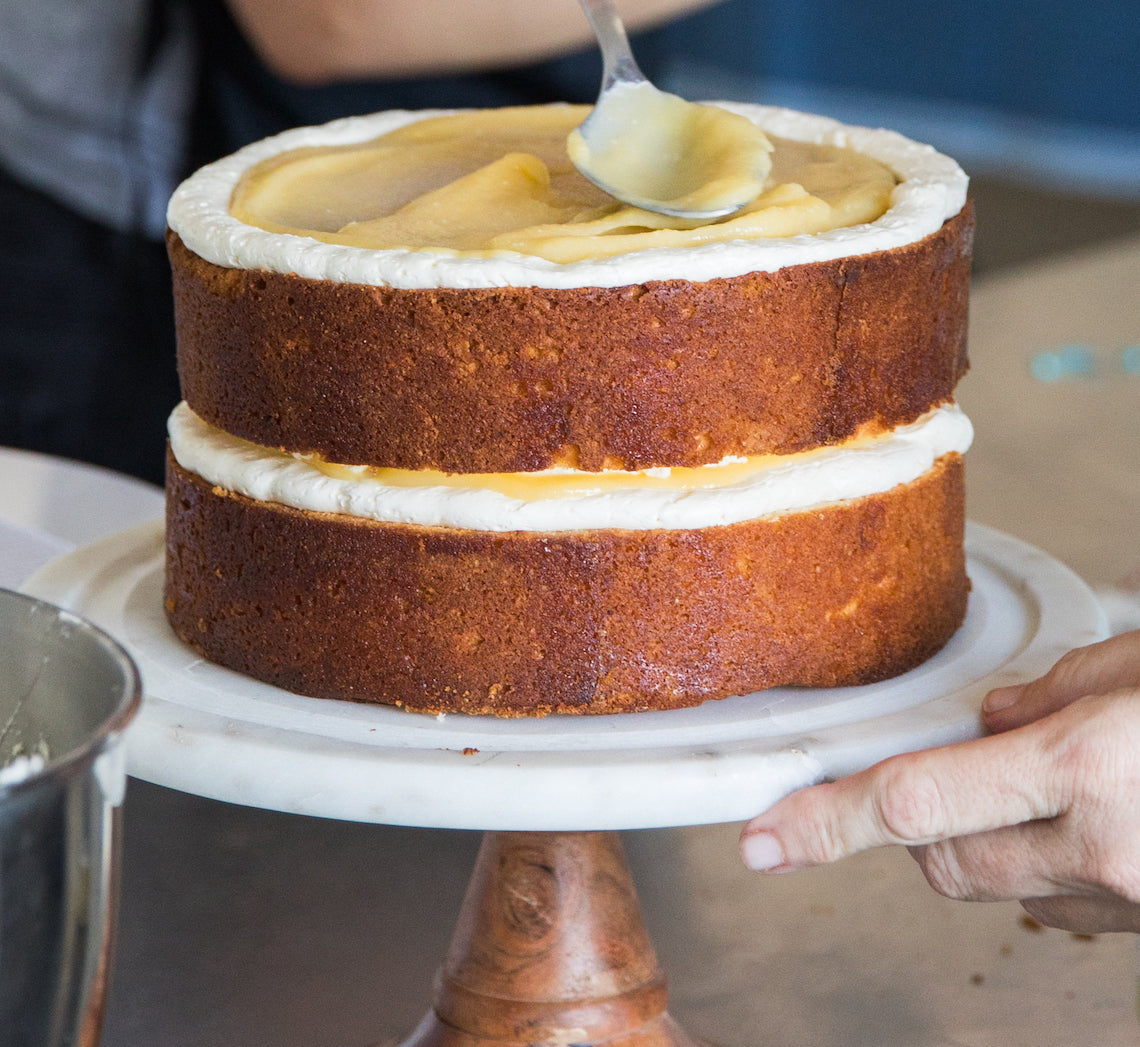
Prep 20min (+ cooling time)Bake 50-55minMakes 10 serves
Simple yet sublime. This pound cake is infused with a tangy lemon syrup and is perfect to serve on its own with a cuppa or used as a base for a more elaborate celebration cake. This recipe was originally published in BakeClass.
Ingredients
- Melted butter, to grease
250g unsalted butter at room temperature, cubed
220g (1 cup) caster sugar
Finely grated lemon zest of 1 lemon
4 eggs, at room temperature
250g (1⅔ cups) plain flour
2½ teaspoons baking powder
2 tablespoons strained freshly squeezed lemon juice
Lemon Syrup
55g (¼ cup) caster sugar
2 tablespoons strained freshly squeezed lemon juice
Method
- Preheat oven to 180°C (160°C fan-forced). Grease a 20cm (base measurement) round cake tin or springform pan with melted butter and line the base with baking paper.
- Using an electric mixer beat the butter, sugar and lemon zest in a large bowl until pale and creamy.
- Add the eggs one at a time, beating well after each addition.
- Sift together the flour and baking powder. Use a spatula to fold half of the flour mixture through the batter mixture. Fold in the lemon juice and then the remaining flour mixture until just combined.
- Spoon the batter into the prepared tin and smooth the surface with the back of a spoon. Bake in preheated oven for 50-55 minutes or until a skewer inserted in the centre comes out clean.
- Meanwhile, to make the Lemon Syrup, combine the caster sugar and lemon juice in a small saucepan and stir over medium heat until the sugar dissolves. Remove from the heat and set aside until the cake is cooked.
- Immediately after removing the cake from the oven, brush the top with a little of the syrup. Leave the cake to stand in the tin for 5 minutes before turning out onto a wire rack. Brush the top of the cake with the remaining syrup and set aside to cool.
Baker's Tips
- This cake will keep in an airtight container at room temperature for up to 2 days.
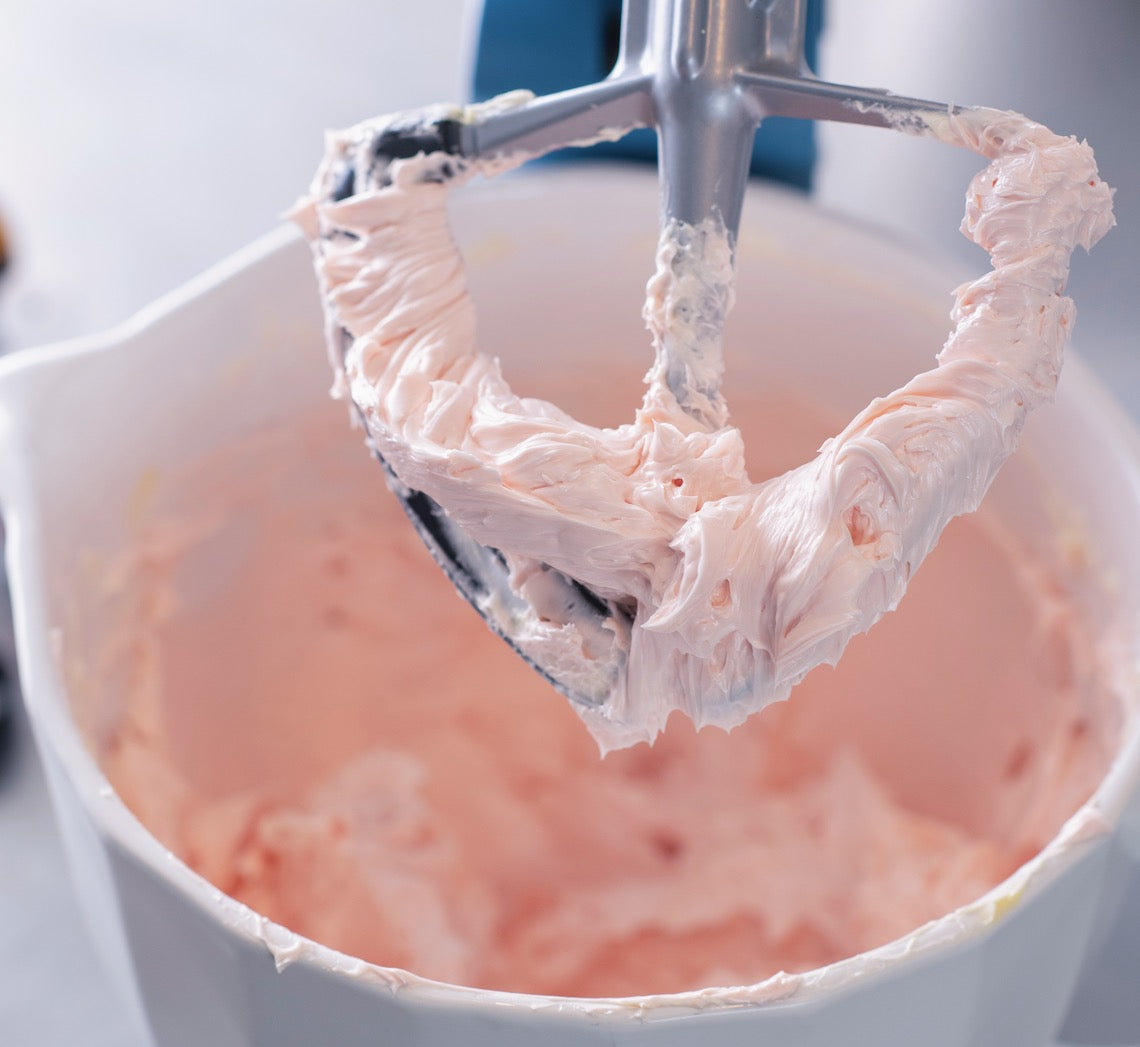
Prep 35-40minMakes about 3 cups
Ingredients
4 egg whites (from 59g/2oz eggs), at room temperature
220g (1 cup/7¾oz) caster sugar
250g (9oz) unsalted butter, cut into 8 equal portions, at room temperature
Good pinch of salt, or to taste
1 teaspoon natural vanilla essence or extract, or to taste
Food colouring gel of your choice (optional)
Method
- Combine the egg whites and sugar in a large heatproof bowl and place over a saucepan of barely simmering water (make sure the bowl does not touch the water). Stir with a whisk until the sugar is dissolved and the mixture reaches 65°C/150°F on a sugar thermometer.
- Transfer the mixture to the bowl of a stand mixer and whisk on medium-high speed with the whisk attachment for 10-15 minutes or until very thick and glossy and the mixture has cooled completely to room temperature.
- Replace the whisk attachment with the paddle beater. Beat on medium-high speed using the paddle beater for about 10 minutes adding a portion of butter one at a time and beating well after each addition until completely incorporated and smooth before adding the next portion of butter. If the mixture becomes lumpy or looks slightly curdled at any stage increase the speed to high and beat until smooth before adding the next portion of butter.
- Reduce speed to medium-low and beat for 3-4 minutes and the mixture is smooth and creamy. Beat in the salt and vanilla. Tint with gel colour to desired colour if using. Use imediately.
Baker's Tips
- This buttercream will keep in an airtight container in the fridge for up to 3 days or freezer for up to 3 months. Before using bring to room temperature/thaw and then beat with the paddle attachment on low speed for 4-5 minutes or until silky smooth again. Use immediately after beating.
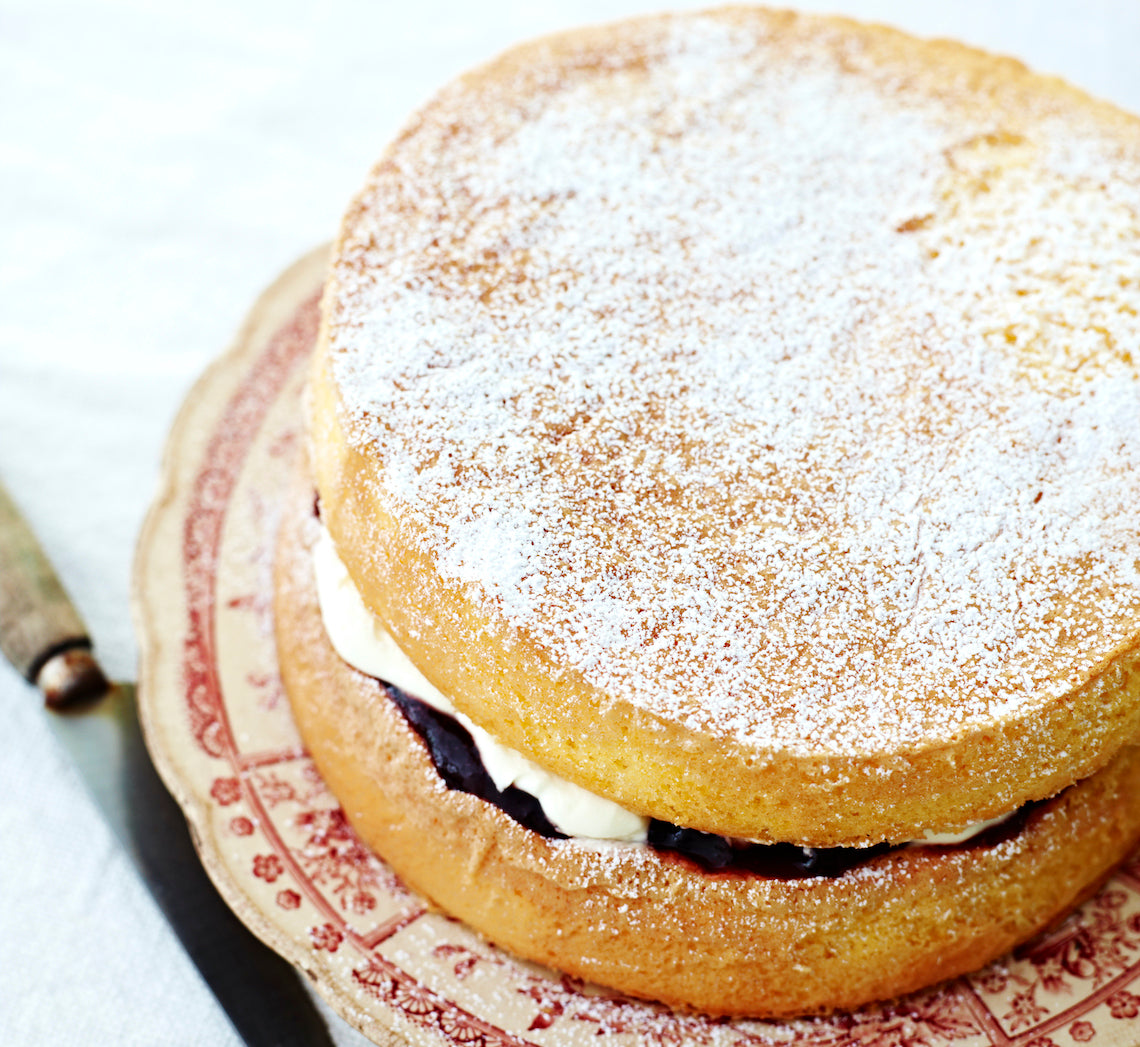
Prep 25minBake 18-20minMakes 8 serves
There are two main tricks when making a sponge: don’t over whisk the mixture once you have added the flour, and keep a close eye on your sponge in the oven – it will be dry if over baked.
Ingredients
15g butter, melted and combined with 1½ teaspoons plain flour
4 x 59g eggs, at room temperature
165g (¾ cup) caster sugar
60ml (¼ cup) milk
30g butter, room temperature, diced
110g (¾ cup) self-raising flour, plus extra to dust
30g (¼ cup) cornflour
125ml (½ cup) pure cream, chilled
225g (⅔ cup) strawberry or raspberry jam
Icing sugar, to dust
Method
- To make the Sponge Layers, place the oven rack in the oven so that the cake tins will sit in the middle of the oven and then preheat it to 180°C (160°C fan-forced). Brush two shallow 20cm/8in round cake tins with the melted butter mixture to grease and line the base of each with a round of non-stick baking paper. Brush the bases again with the melted butter mixture.
- Use an electric mixer with a whisk attachment on medium-high speed to whisk the eggs in a large bowl until frothy. Add the sugar a spoonful at a time, whisking well after each addition, until the mixture is very thick and pale (this will take about 8 minutes). Lift the whisk out of the mixture and draw a figure eight, if the trail stays on the surface long enough to finish drawing, then the mixture is ready. If not, continue to whisk for a further minute.
- Meanwhile, heat milk and butter in a small saucepan over medium heat until almost simmering. Remove from heat and pour down the side of the mixing bowl. Quickly sift the flour and cornflour together over the egg mixture and then immediately whisk again with the electric mixer on low speed briefly until the flour mixture is just incorporated (be careful not to overmix). Scrape the base of the bowl and then whisk briefly again, if necessary.
- Divide the mixture evenly between the cake tins (see Baker’s Tips) and gently tap the tins on the bench top three times to settle the mixture. Bake in preheated oven for 18-20 minutes or until the cakes are a pale golden colour, spring back when lightly touched in the centre and start pulling away from the sides of the tins. Remove from the oven and immediately use a small palette knife to loosen the top of the sponges from the tins and turn onto a wire rack (see Baker’s Tips), top side up, to cool completely.
- When ready to fill, use a hand-held electric mixer with a whisk attachment or a balloon whisk to whisk the cream until soft-firm peaks form. Spread one cake with the jam and then the whipped cream. Top with the remaining cake and dust with icing sugar.
Baker's Tips
- To divide the mixture evenly between the tins, weigh the tins with the mixture in them to make sure they are the same weight.
- When removing the cakes from the tins, turn them onto a wire rack covered with a tea towel before inverting onto another rack. The tea towel will prevent the rack marking the tops of the cakes.
- Sponge cakes are best eaten the day they are baked. Sandwich them together just before serving.
Photography by Julie Renouf.
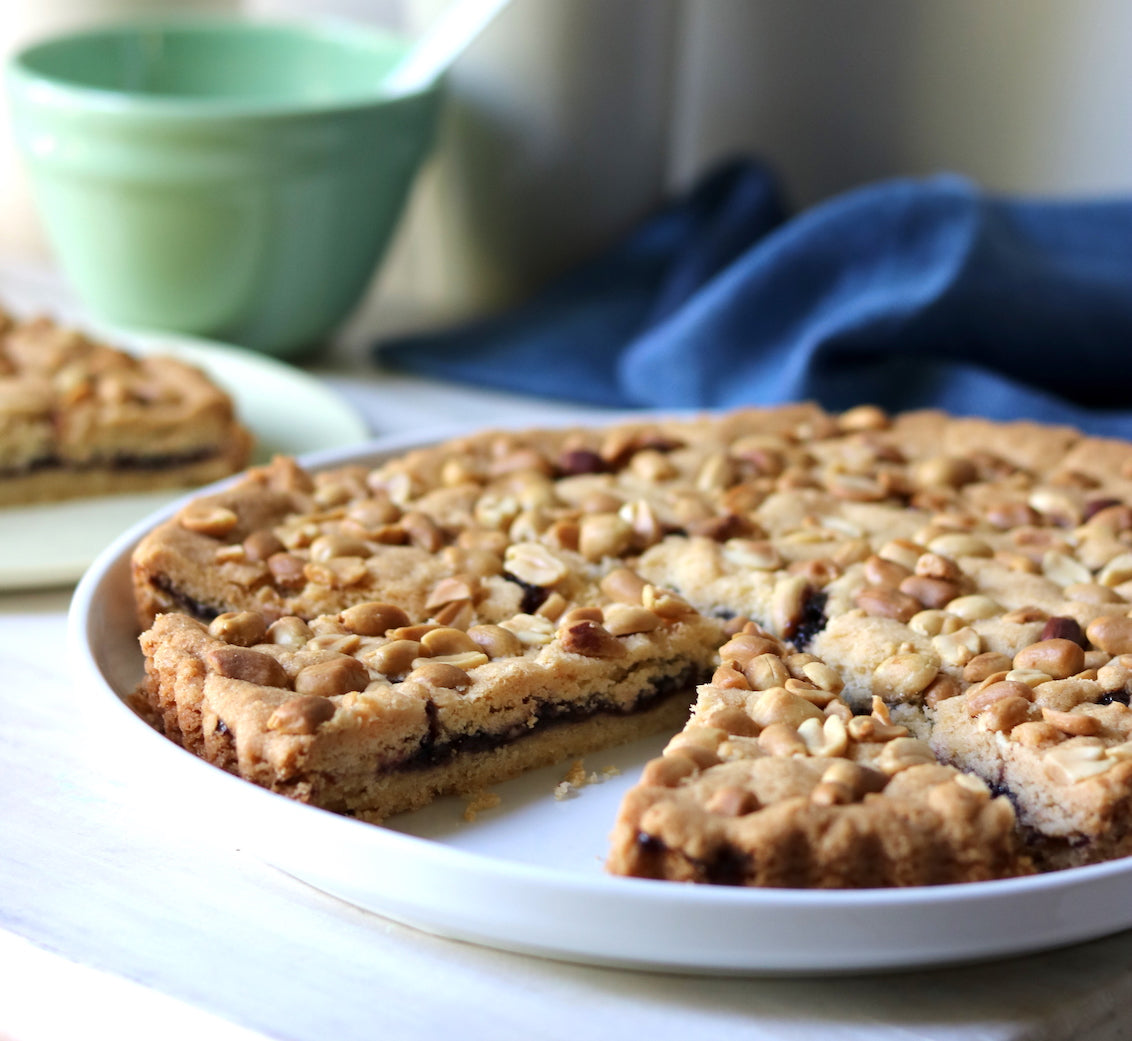
Prep 20min (+cooling time)Bake 35-40minMakes 8-10 serves
I love this tart – a no-fuss, slice-like affair of buttery shortbread layers filled with jam and nuts. Research has revealed no reason why this tart is Belgian, but it brings back vivid childhood memories of my mum, Jocelyn, making it in two enamel plates, throwing them in the oven and then, once cool, covering them with foil to take to a picnic or tennis day. I remember it so clearly when I make the tart now (with a few small alterations) in my own kitchen.
Ingredients
185g (6½oz) salted butter, softened slightly
150g (5¼oz) caster sugar
1 egg yolk
1 teaspoon natural vanilla essence or extract
260g (9¼) plain flour
1 teaspoon baking powder
165g (5¾oz) mixed berry jam (see Baker’s Tips)
70g (½ cup/6oz) unsalted raw peanuts (or nuts of your choice)
Method
- Preheat the oven to 160°C/315°F (140°C/285°F fan-forced).
- Put the butter and sugar in the bowl of a food processor and process until well combined. Add the egg yolk and vanilla and process to combine, scraping down the side of the bowl if necessary. Sift together the flour and baking powder. Add to the butter mixture and use the pulse butter to process until just combined and a soft dough forms.
- Press half of the mixture evenly over the base of an ungreased 23cm/9in tart tin with removable base. Spread evenly with the jam, leaving a 2cm/¾in border. Press portions of the remaining dough between your hands to flatten and press over the jam to cover, patching where necessary. Sprinkle with the peanuts and press into the dough.
- Place the tart tin on a baking tray and bake in preheated oven for 35-40 minutes or until golden and cooked through. Leave the tart to cool in the tin and then serve in wedges.
Baker's Tips
- Mum used to make this tart with apricot jam instead of the mixed berry I have used in this recipe but any jam variety works well – fig, blackberry, raspberry - just pick your favourite.
- This tart will keep in an airtight container at room temperature for up to 4 days.
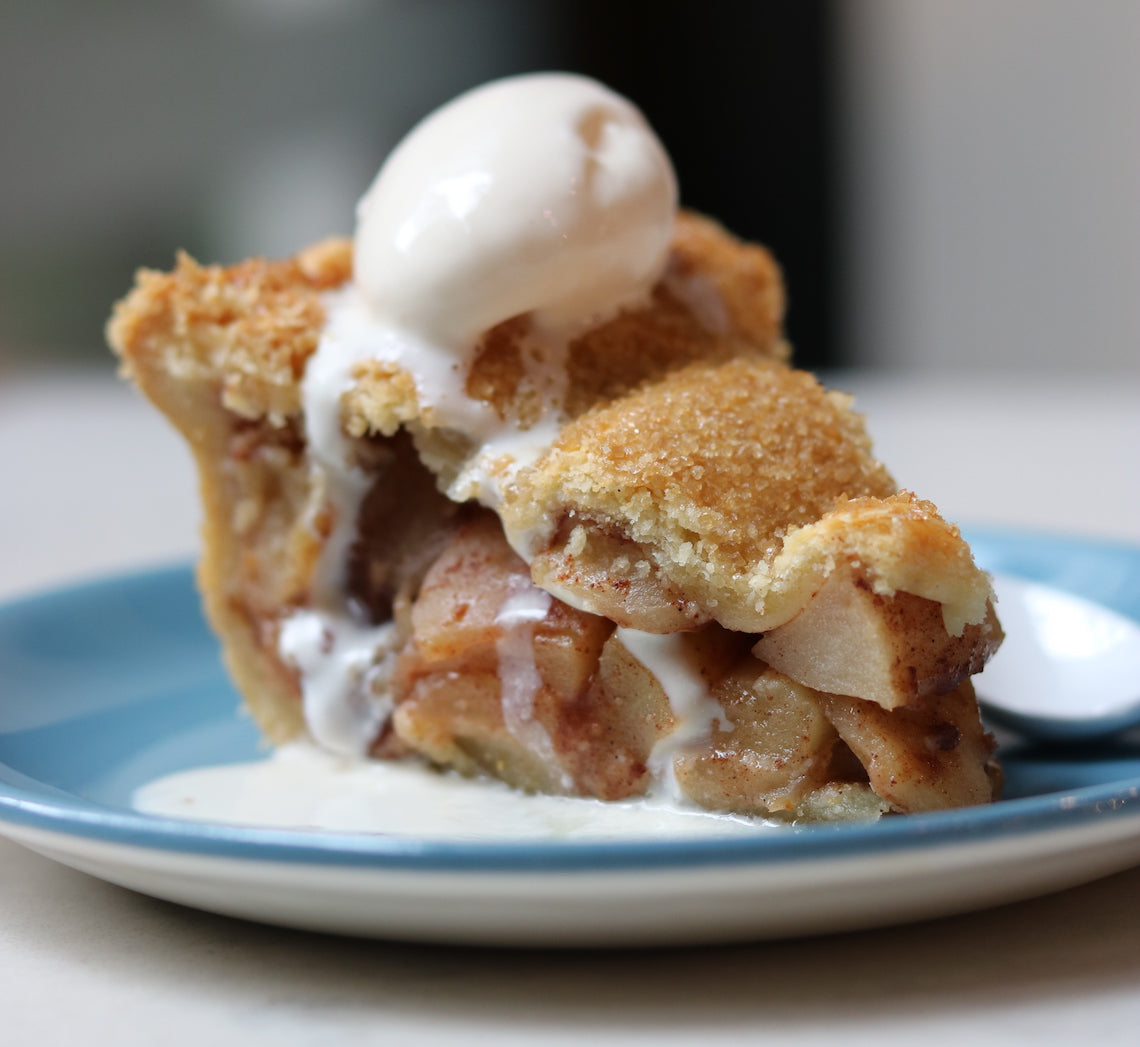
Prep 15min (+chilling time)
Shortcrust pastry, when you have a good recipe, is one of the simplest and quickest pastries to make. This sweet vanilla variety is great with a Classic Apple Pie.
Ingredients
200g (1⅓ cups) plain flour
2 tablespoons almond meal
2 tablespoons caster sugar
150g chilled salted butter, cubed
3 tablespoons iced water
1 teaspoon vanilla bean paste
Method
- Combine the flour, almond meal and caster sugar in the bowl of a food processor. Add the butter and use the pulse button to pulse until the mixture resembles fine breadcrumbs.
- Remove the lid of the food processor and sprinkle the water over the flour mixture and then add the vanilla bean paste. Continue to process using the pulse button until the mixture is evenly combined and just starts to come together (but hasn’t as yet formed a ball). The pastry should be soft but not sticky.
- Turn the pastry out onto a lightly floured, cool bench top. Knead lightly with your fingertips for about 10 seconds or until it comes together but isn’t completely smooth. Shape the pastry into a disc, wrap well in plastic wrap, and chill and use as directed.






